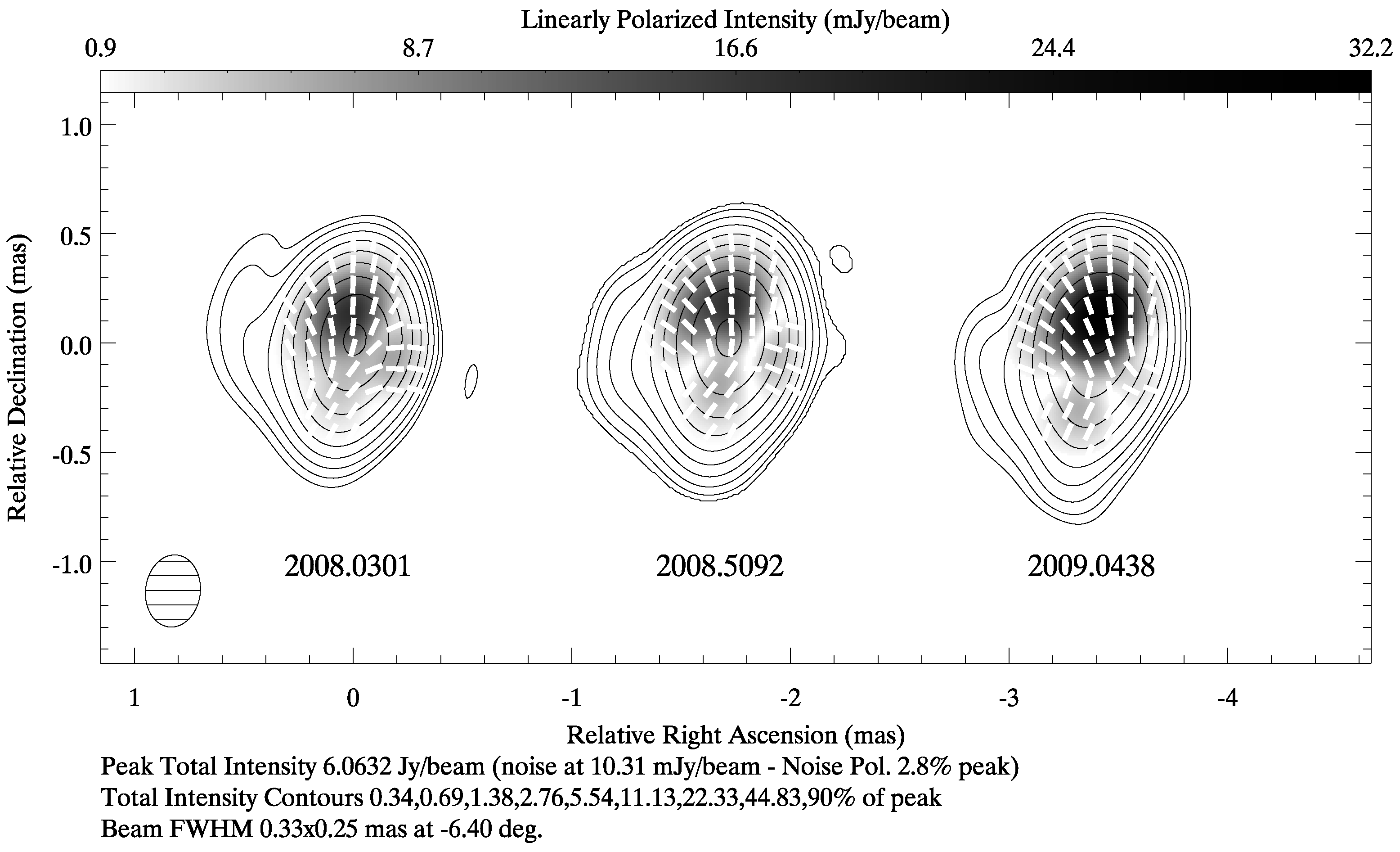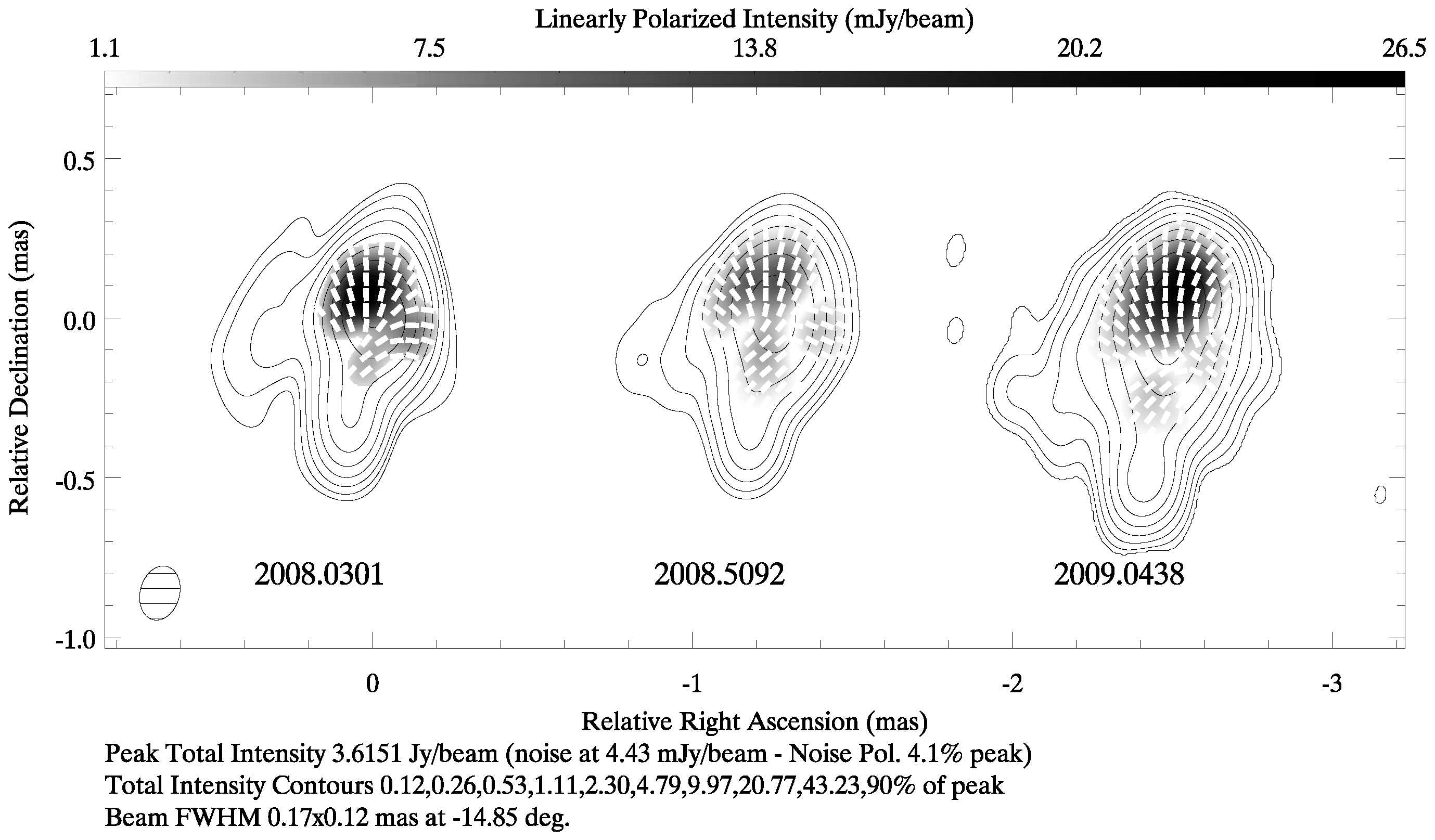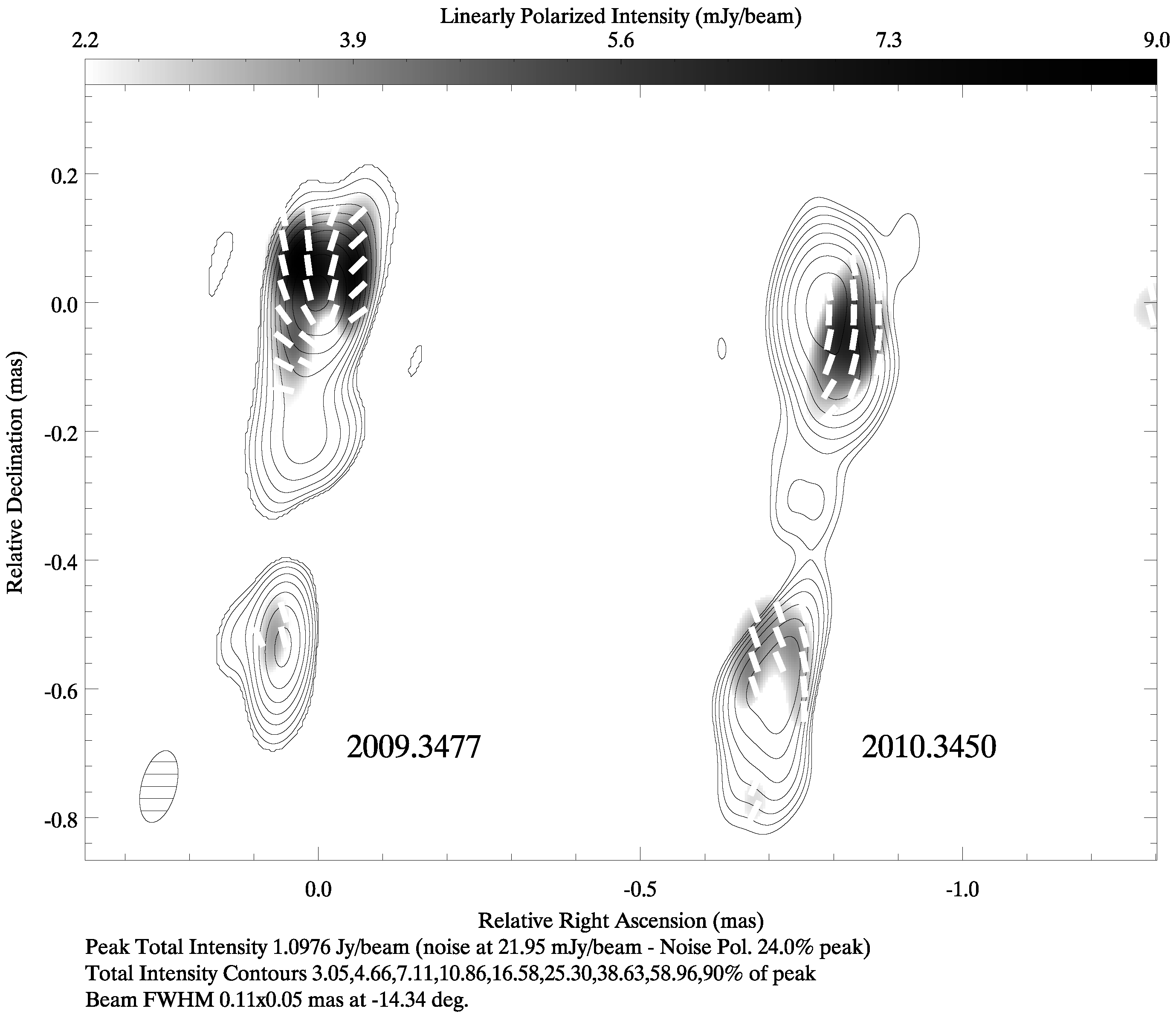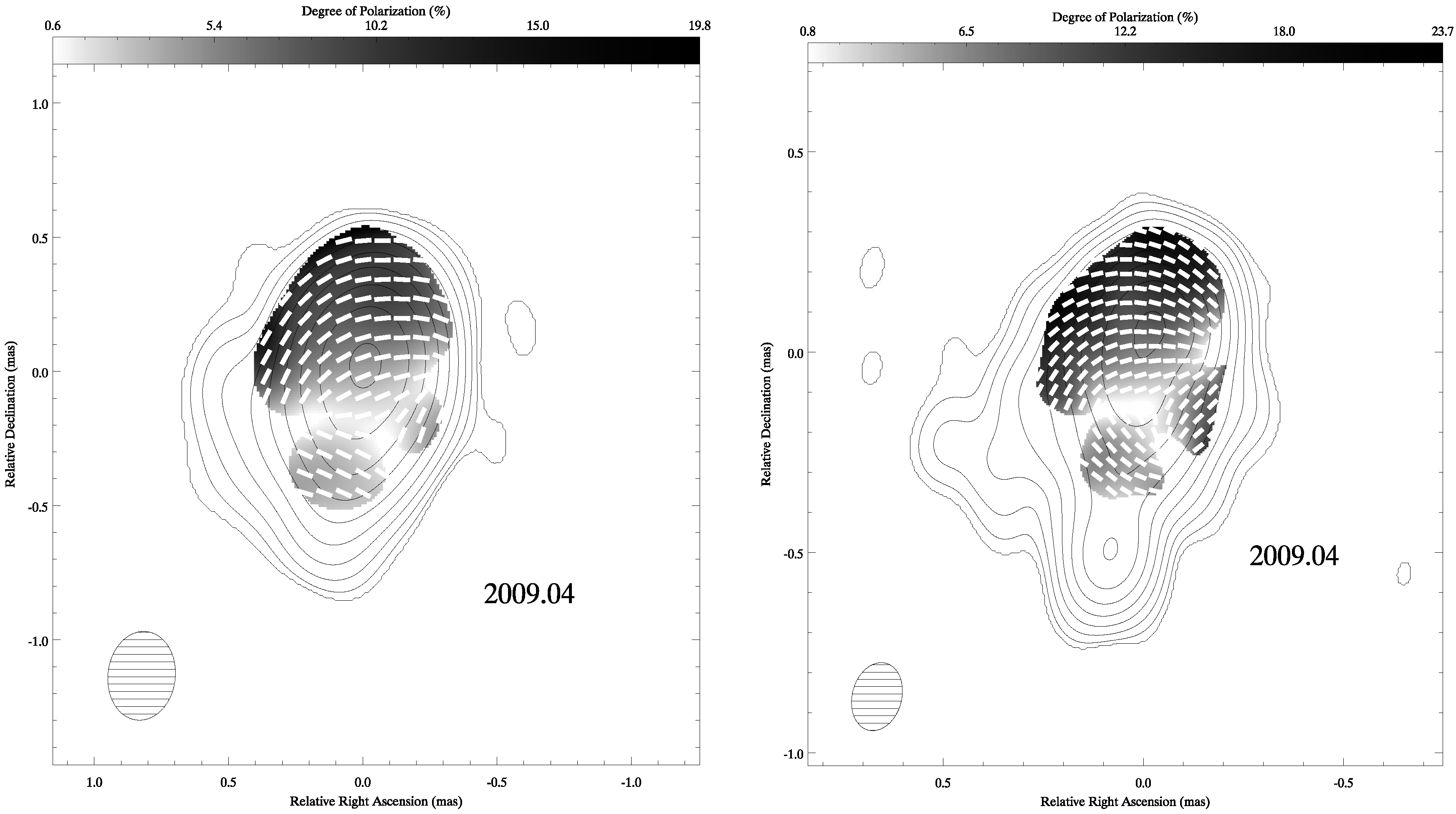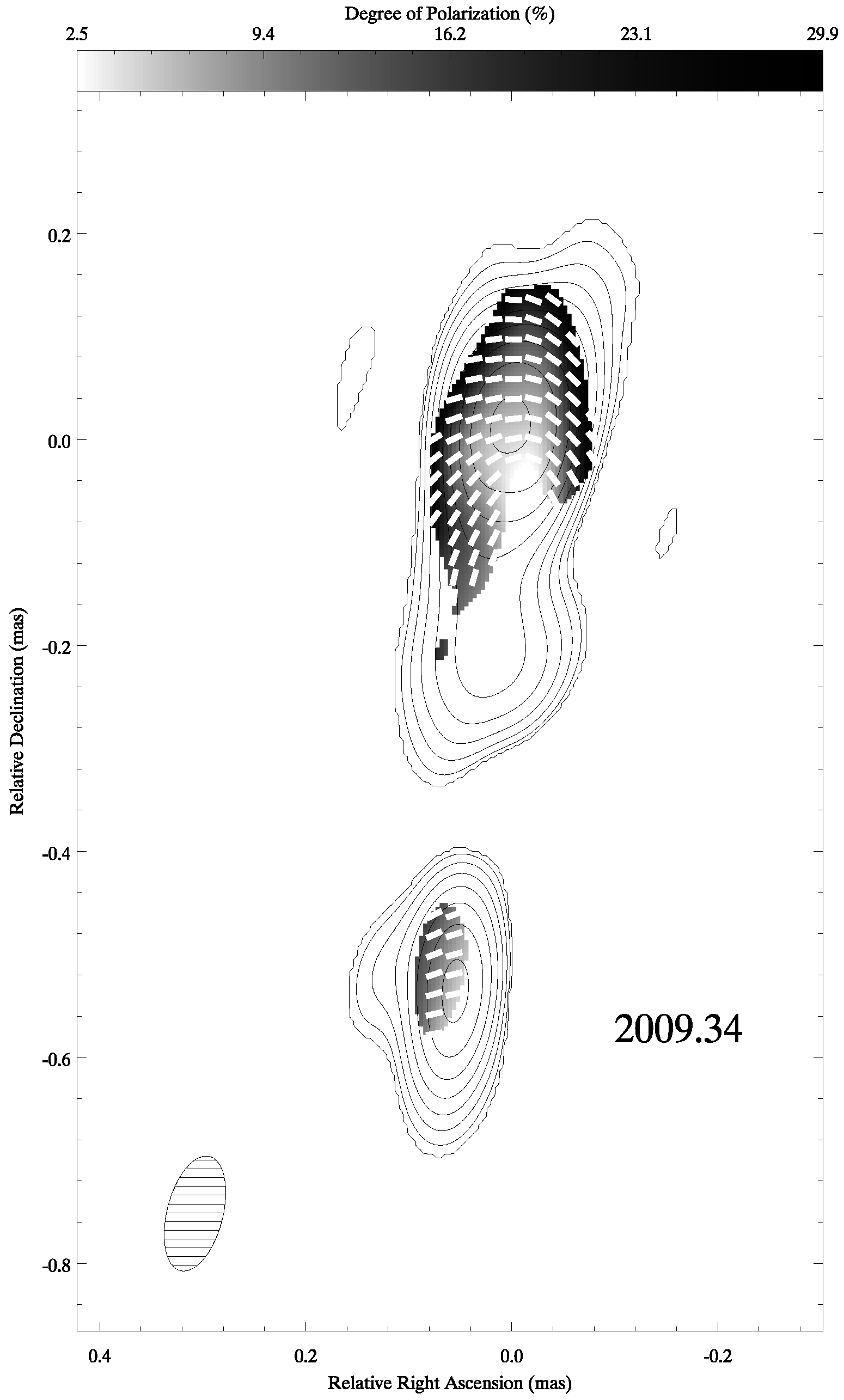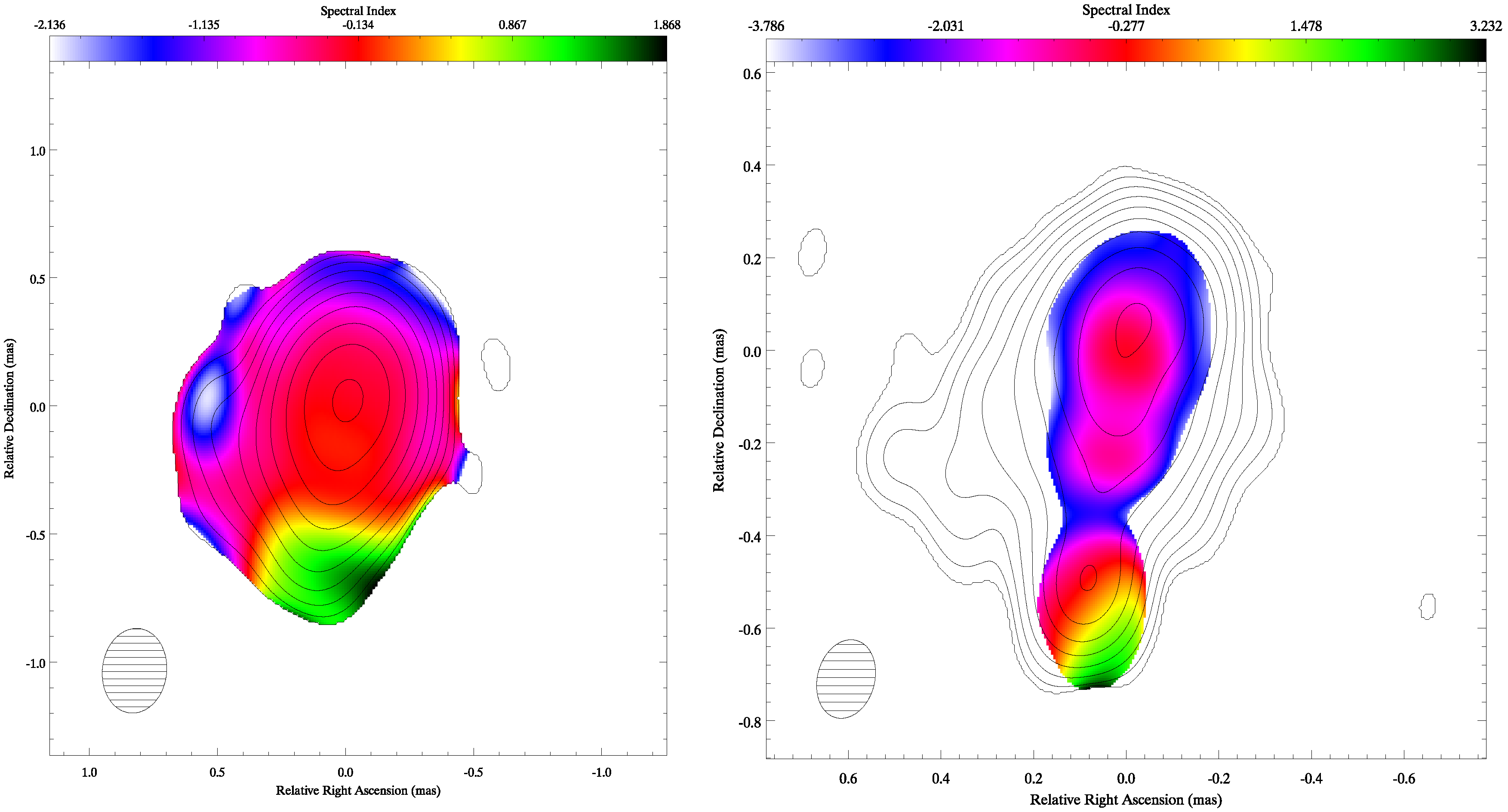1. Introduction
Most formation models and numerical simulations propose a helical magnetic field to form, accelerate and collimate jets in active galactic nuclei (AGN) [
1,
2,
3]. In fact, current models invoke rotation of the accretion disk or black hole ergosphere to create a helical magnetic field [
4,
5,
6].
Despite a variety of observations that provide evidence of helical jet magnetic fields, there has been no previous report of imaging of a polarization structure that appears to directly correspond to the sky projection of a helical magnetic field in the innermost (parsec scale) jet.
Several sources have shown transverse gradients in the observed rotation measure (RM) which suggests that the media that produces the RM gradient has a helical magnetic field structure [
7,
8,
9,
10,
11,
12]. However, these kind of observations have uncertainties related to the difficulty in discriminating whether the Faraday rotating media is internal to the jet emitting region (in which case the helical magnetic field detected is directly related with the magnetic field of the jet) or external.
Moreover, in 3C 454.3 an arc-like feature has been observed with a polarization structure that shows evidence that is compatible with the idea of a helical magnetic field, although for spatial scales of the order of tens of parsecs [
13].
Studying the polarization structure with millimeter VLBI can reveal the magnetic configuration in the innermost jet regions. Furthermore, extending polarimetric studies to higher frequencies (above 43 GHz) is important to understand the jet physics near the central black hole in AGN.
The quasar NRAO 150 is a very good candidate to study the structure of the magnetic field. It is a powerful quasar at z = 1.52 [
14] and the innermost regions of the jet are oriented within a very small angle to the line of sight [
15]. Agudo et al., (2007) [
15] measured extremely fast swings of the inner jet structure in the counterclockwise direction at an angular rate of up to ≈ 11
/year. This angular speed was estimated by assuming that the brightest jet feature in most 43 GHz VLBI images was the core of the jet (called Q0 in this work), therefore assumed to be stationary, and the position of the remaining components were measured with respect to Q0.
Very Long Baseline Interferometry (VLBI) has provided the ultra- high-resolution that is necessary to study the innermost part of the jets. In this work, we have used the Very Long Baseline Array (VLBA) and Global Millimeter VLBI Array (GMVA) images of the total and linearly polarized intensity distributions of NRAO 150 at 22, 43 and 86 GHz.
2. Observations and Data Reduction
We present VLBA observations of the jet in the quasar NRAO 150 at 22 and 43 GHz, between 2008 and 2009. We also show two images taken with the GMVA at 86 GHz between 2009 and 2010. The GMVA is the instrument that provides the best angular resolution from ground telescopes. The initial phase and amplitude calibration of the total flux and polarimetric data was performed with the AIPS software in the usual manner [
16].
Analysis of the instrumental polarization at 86 GHz shows that they remain reasonably stable across our observing epochs. Calibration of the electric vector position angle (EVPA) at 22, 43 and 86 GHz was obtained by comparison of the integrated polarization measured from VLBA images for NRAO 150 and three calibrators (BL Lac, DA 193, OJ 287) with VLA observations at contemporaneous epochs at 22 and 43 GHz; and with single-dish polarimetric observations of NRAO 150 obtained by the IRAM 30 m telescope at 86 GHz. Estimated errors of this EVPA calibration lie in the range between and .
3. Direct Evidence of a Helical Magnetic Field
Figure 1 and
Figure 2 show a sequence of VLBA images at three epochs between 2008 and 2009 of the polarized intensity and EVPA at 22.2 and 43.2 GHz.
Figure 3 shows the images at two epochs obtained with the GMVA at 86 GHz. At these high frequencies, the jet is mainly extending in the north–south direction.
At 86 GHz, it is possible to observe the innermost structure of the jet in NRAO 150. The total intensity and polarization structure is fully consistent with the structure observed at lower frequencies, hence confirming the good capabilities of the GMVA to obtain ultra-high-resolution polarization imaging [
17].
In jets, the total emission at radio frequencies is produced by synchrotron radiation. Because of that, the degree of linear polarization provides relevant information about the level of order of magnetic fields along the line of sight. In NRAO 150, the degree of linear polarization distribution is variable in time, showing a peak in the northern region (≃14%) during 2009 (
Figure 4 and
Figure 5). This implies that during this epoch the northern region is dominated by a better ordered field.
Figure 4 and
Figure 5 show the magnetic vector position angle (considered perpendicular to the electric vector position angle) distribution during 2009 at 22, 43 and 86 GHz. The assumption that a good representation of the magnetic field may be obtained by the rotation of the EVPA by 90 degrees is supported by the spectral index distribution showed in
Figure 6, which shows that the emission is mainly optically thin. In order to obtain the spectral index distribution, we have used two methods to align the images at different frequencies. We have used the cross identification of a particular optically thin emission feature, and the two-dimensional (2D) cross-correlation of the optically thin emission distribution of the source [
18,
19]. In all cases, we used the restoring beam size of the lower frequency image for every pair of images to be compared. We have found that the two-dimensional (2D) cross-correlation gives us more consistent results than the other method. This is expected, considering that the (2D) cross-correlation takes into account all optically thin emission regions on the entire source, not just a particular feature. The detailed method used for making our spectral index maps was published in [
20].
At all frequencies, we observe a magnetic vector position angle configuration that shows a circular geometry. This circular polarization structure has not been observed previously in any other source.
Previous studies of this source found a first approximation of the jet viewing angle ≈8
, remarking that the extreme jet misalignment between the orientation of the sub-mas scale jet, with respect to the larger scales, implies a very small viewing angle (probably smaller than
) [
15]. Spectral index maps show that there is not a preferential optically thick region that could be assumed as the millimeter core of the jet. Considering this, the circular polarization structure can be interpreted as evidence of the toroidal component of the magnetic field onto the plane of the sky.
Acknowledgments
The research at the IAA-CSIC is supported by the Spanish Ministry of Economy and Competitiveness (MINECO) grant AYA2013-40825-P. I.A. acknowledges support by a Ramón y Cajal grant of MINECO. The VLBA is an instrument of the National Radio Astronomy Observatory, a facility of the National Science Foundation operated under cooperative agreement by Associated Universities, Inc. The GMVA is operated by the MPIfR, IRAM, NRAO, OSO, and MRO.
Author Contributions
The order in the authors list represents the contribution to this work.
Conflicts of Interest
The authors declare no conflict of interest.
References
- Meier, D.L.; Koide, S.; Uchida, Y. Magnetohydrodynamic Production of Relativistic Jets. Science 2001, 291, 84–92. [Google Scholar] [CrossRef] [PubMed]
- Hardee, P.E.; Walker, R.C.; Gómez, J.L. Modeling the 3c 120 radio jet from 1 to 30 milliarcseconds. Astrophys. J. 2005, 620, 646–664. [Google Scholar] [CrossRef]
- McKinney, J.C. General relativistic magnetohydrodynamic simulations of the jet formation and large-scale propagation from black hole accretion systems. Mon. Not. R. Astron. Soc. 2006, 368, 1561–1582. [Google Scholar] [CrossRef]
- Vlahakis, N.; Konigl, A. Magnetic driving of relativistic outflows in active galactic nuclei. I. Interpretation of parsec-scale accelerations. Astrophys. J. 2004, 605, 656–661. [Google Scholar] [CrossRef]
- Komissarov, S.S.; Barkov, M.; Vlahakis, N.; Königl, A. Magnetic acceleration of relativistic active galactic nucleus jets. Mon. Not. R. Astron. Soc. 2007, 380, 51–70. [Google Scholar] [CrossRef]
- Marscher, A.P.; Jorstad, S.G.; D’Arcangelo, F.D.; Smith, P.S.; Williams, G.G.; Larionov, V.M.; Oh, H.; Olmstead, A.R.; Aller, M.F.; Aller, H.D.; et al. The inner jet of an active galactic nucleus as revealed by a radio-to-gamma-ray outburst. Nature 2008, 452, 966–969. [Google Scholar] [CrossRef] [PubMed]
- Gómez, J.L.; Marscher, A.P.; Jorstad, S.G.; Agudo, I.; Roca-Sogorb, M. Faraday Rotation and Polarization Gradients in the Jet of 3C 120: Interaction with the External Medium and a Helical Magnetic Field? Astrophys. J. Lett. 2008, 681, L69. [Google Scholar] [CrossRef]
- Croke, S.M.; O’Sullivan, S.P.; Gabuzda, D.C. The parsec-scale distributions of intensity, linear polarization and Faraday rotation in the core and jet of Mrk 501 at 8.4–1.6 GHz. Mon. Not. R. Astron. Soc. 2010, 402, 259–270. [Google Scholar] [CrossRef]
- Gómez, J.L.; Roca-Sogorb, M.; Agudo, I.; Marscher, A.P.; Jorstad, S.G. On the source of faraday rotation in the jet of the radio galaxy 3c 120. Astrophys. J. 2011, 733, 11. [Google Scholar] [CrossRef]
- Hovatta, T.; Lister, M.L.; Aller, M.F.; Aller, H.D.; Homan, D.C.; Kovalev, Y.Y.; Pushkarev, A.B.; Savolainen, T. Mojave: Monitoring of jets in active galactic nuclei with VLBA experiments. VIII. Faraday rotation in parsec-scale agn jets. Astron. J. 2012, 144, 105H. [Google Scholar] [CrossRef]
- Algaba, J.C. High-frequency Very Long Baseline Interferometry rotation measure of eight active galactic nuclei. Mon. Not. R. Astron. Soc. 2013, 429, 3551–3563. [Google Scholar] [CrossRef]
- Gabuzda, D.C.; Knuettel, S.; Reardon, B. Transverse Faraday-rotation gradients across the jets of 15 active galactic nuclei. Mon. Not. R. Astron. Soc. 2015, 450, 2441. [Google Scholar] [CrossRef]
- Zamaninasab, M.; Savolainen, T.; Clausen-Brown, E.; Hovatta, T.; Lister, M.L.; Krichbaum, T.P.; Kovalev, Y.Y.; Pushkarev, A.B. Evidence for a large-scale helical magnetic field in the quasar 3C 454.3. Mon. Not. R. Astron. Soc. 2013, 436, 3341–3356. [Google Scholar] [CrossRef]
- Acosta-Pulido, J.A.; Agudo, I.; Barrena, R.; Almeida, C.R.; Manchado, A.; Rodríguez-Gil, P. The redshift and broad-band spectral energy distribution of NRAO 150. Astron. Astrophys. 2010, 519, A5. [Google Scholar] [CrossRef]
- Agudo, I.; Bach, U.; Krichbaum, T.P.; Marscher, A.P.; Gonidakis, I.; Diamond, P.J.; Perucho, M.; Alef, W.; Graham, D.A.; Witzel, A.; et al. Superluminal non ballistic jet swing in the quasar NRAO150 revealed by mm-VLBI. Astron. Astrophys. 2007, 476, L17–L20. [Google Scholar] [CrossRef]
- Leppanen, K.J.; Zensus, J.A.; Diamond, P.J. Linear Polarization Imaging with Very Long Baseline Interferometry at High Frequencies. Astron. J. 1995, 110, 2479. [Google Scholar] [CrossRef]
- Marti-Vidal, I.; Krichbaum, T.P.; Marscher, A.; Alef, W.; Bertarini, A.; Bach, U.; Schinzel, F.K.; Rottmann, H.; Anderson, J.M.; Zensus, J.A.; et al. On the calibration of full-polarization 86 GHz global VLBI observations. Astron. Astrophys. 2012, 542, A107. [Google Scholar] [CrossRef]
- Walker, R.C.; Dhawan, V.; Romney, J.D.; Kellermann, K.I.; Vermeulen, R.C. VLBA absorption imaging of ionized gas associated with the accretion disk in NGC 1275. Astrophys. J. 2000, 530, 233. [Google Scholar] [CrossRef]
- Croke, S.M.; Gabuzda, D.C. Aligning VLBI images of active galactic nuclei at different frequencies. Mon. Not. R. Astron. Soc. 2008, 386, 619–626. [Google Scholar] [CrossRef]
- Molina, S.N.; Agudo, I.; Gómez, J.L.; Krichbaum, T.P.; Martí-Vidal, I.; Roy, A.L. Evidence of internal rotation and a helical magnetic field in the jet of the quasar NRAO 150. Astron. Astrophys. 2014, 566, A26. [Google Scholar] [CrossRef]
© 2016 by the authors; licensee MDPI, Basel, Switzerland. This article is an open access article distributed under the terms and conditions of the Creative Commons Attribution (CC-BY) license (http://creativecommons.org/licenses/by/4.0/).
